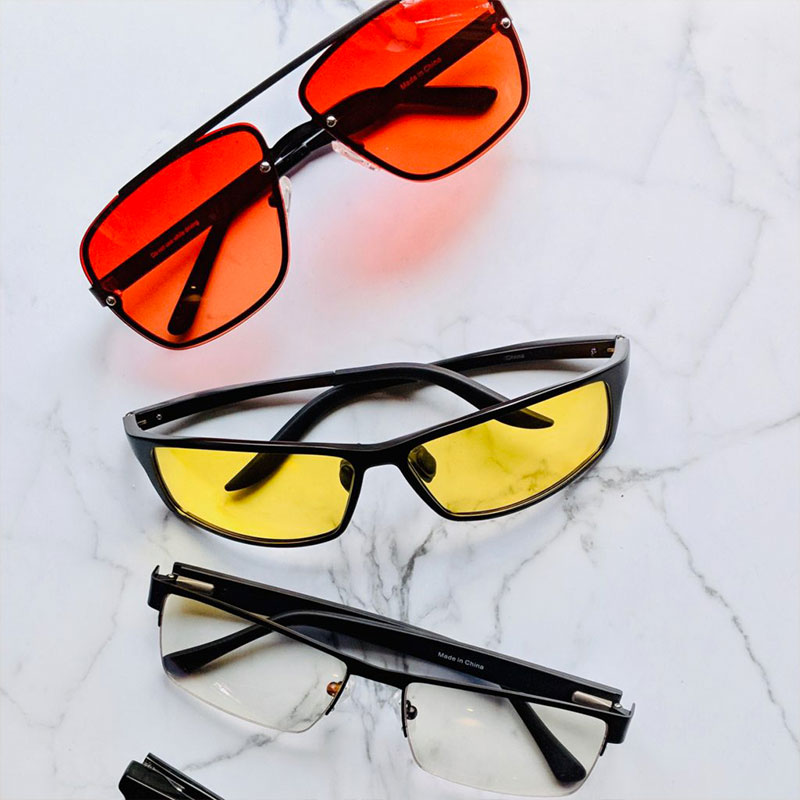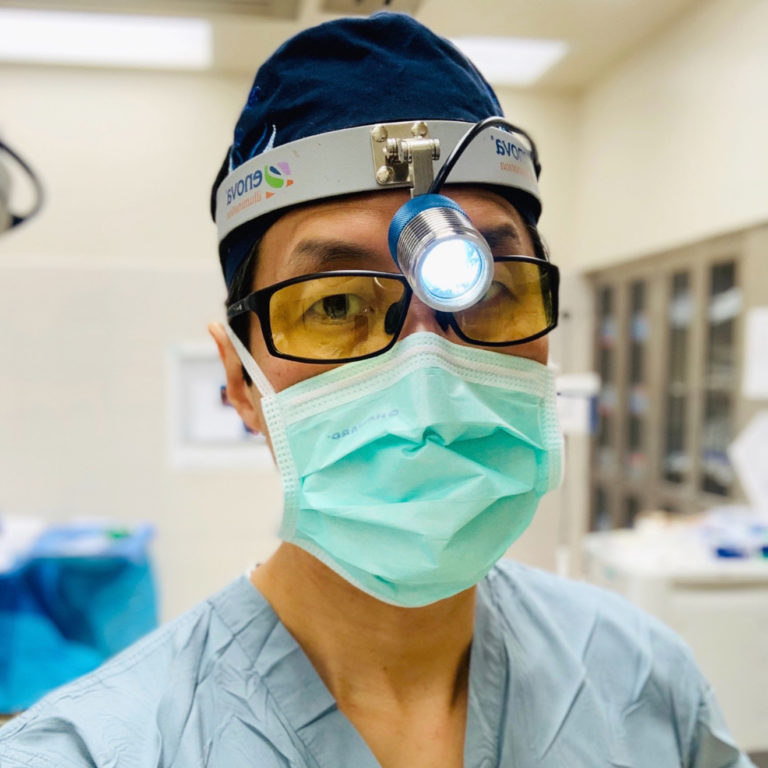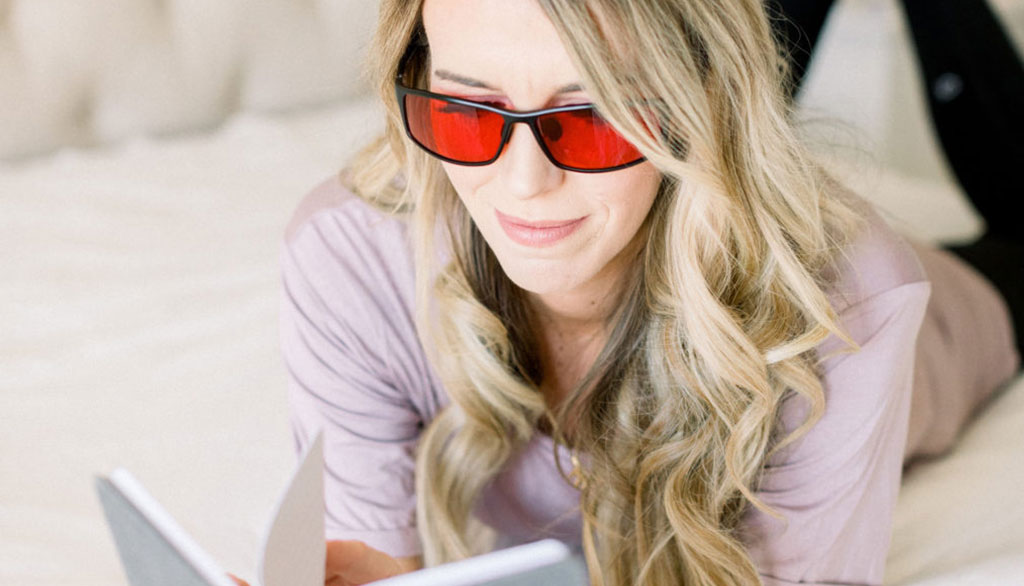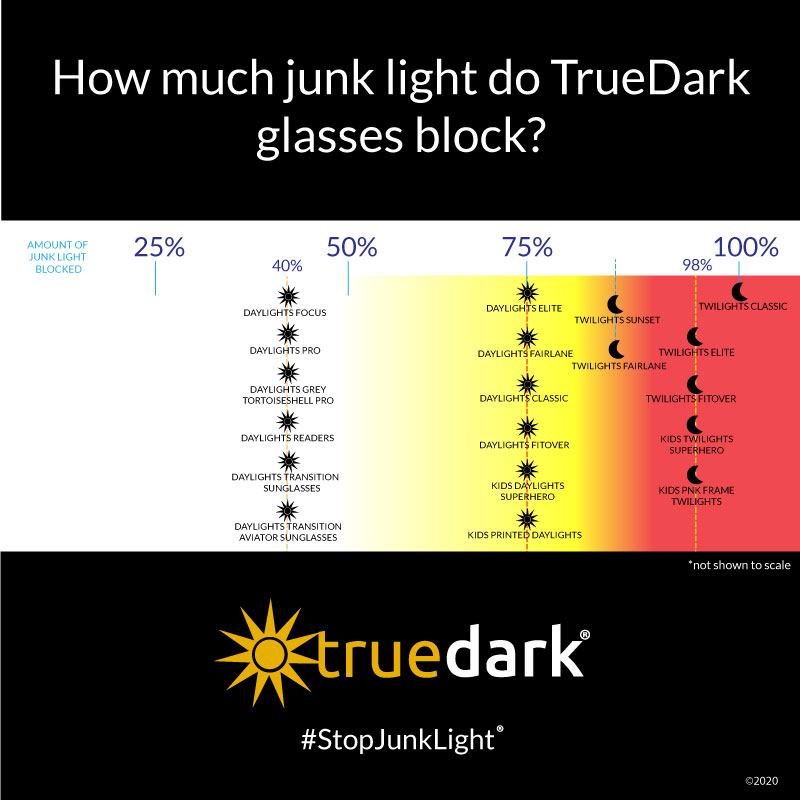Blue Light Lenses That Don't Distort Colors

Article at a Glance:
- People are spending more time exposed to artificial lighting than ever before.
- Overexposure to artificial junk light is not what nature intended; in fact, it can have many adverse effects on your health.
- Blue light blocking glasses are a safe, drug-free solution to help you manage your light exposure throughout the day (and night).
- Too much artificial blue light during the daytime can zap your energy and negatively affect how you feel and function.
- Clear lenses block a maximum of 40% of blue light; yellow lenses block a maximum of 75% of blue light; and red lenses block up to 100% of blue, green and violet light.
- Orange lenses block too much blue light during the day and not enough at night.
- In order to choose the best blue light blocking glasses for you, it's important to take lens color, functionality, and your lifestyle into consideration.
Modern lifestyles are multifaceted, but one thing is for sure: people are spending more time exposed to artificial lighting than ever before. This is largely due to advances in technology, such as the LED revolution and digital devices, as well as longer work hours and greater access to global information.(1) One major downside of more time inside and in front of screens is the potential of circadian rhythm disruption, which can, in turn, lead to numerous health concerns. With light itself being a vital cue for entraining vital biological functions, blue light blocking glasses are a simple and effective solution for managing your light exposure and supporting your natural circadian rhythms. The key to choosing the right blue light blocking glasses comes down to lens color and functionality.

Why does the lens color in my blue light blocking glasses matter?
If you do an online search for "blue light blocking glasses" right now, you'll see hundreds if not thousands of options pop up on your screen. You'll also notice that the lenses are available in different colors – namely clear, yellow, orange, and red. These colors are significant as they affect how much junk light your glasses are actually blocking.
Here is a quick break down of how different colored lenses work:
- Clear lenses block a maximum of 40% of blue light. They are ideal for relieving digital eye strain and improving energy and focus during the daytime. Clear lenses may also be especially helpful for people who need to see true colors on screens and/or stay in uniform at work while also protecting their circadian rhythms."
- Yellow lenses block a maximum of 75% of blue light. They essentially serve the same purpose as the clear lenses except they are arguably more functional in that they block almost twice as much junk light. Note that yellow lenses do NOT block 100% of blue light because not ALL blue light is "bad"; your body needs some blue light during the daytime in order to remain alert and active.
- Orange lenses typically block 98-99% of blue light. The very first blue blockers ever created for NASA's space program had orange lenses. These are probably the most popular colored lenses you'll find, and yet, they aren't as effective as people think. Orange lenses block too much blue light during the daytime and not enough of the junk light spectrum (including green and violet light) at nighttime. Remember that in order to keep your biological rhythms aligned with the natural rise and fall of the sun, you need different amounts of blue light during the daytime and effectively no light at nighttime. (It doesn't matter if you bought a pair of orange lenses for $11 or over $100, they simply aren't as effective as other daytime and nighttime options!)
- Red lenses can block up to 100% of blue, green and violet light. As the sun descends below horizon each night, the sky emits warm colors until it's completely dark out. Red lenses create a similar effect by essentially dimming the lights, even if you still have them on in the hours leading up to bedtime. Still, not all red lenses are the same. Ideally, you want to find lenses that block as much blue, green AND violet light as possible since each of these ranges have been shown to disrupt sleep.(2)
To sum up, here are the key things to remember when choosing the right lens color for your blue light blocking glasses:
- The maximum % blockage numbers listed above aren't just industry standards; they are based on color science. You may still see higher percentages published. Unfortunately, there may be some marketing at play here where companies create their own scale (like SPF ratings associated with sunscreen) and proclaim that their lenses are blocking more than they really do.
- Steer clear of orange lenses if you can. They were once thought to be the most effective, but science shows that the body has a master clock and natural circadian rhythms that ebb and flow. The body needs different amounts of blue light throughout the daytime, and basically no light at nighttime in order to keep these rhythms in sync with the natural rise and fall of the sun. So, it is more effective to have one daytime pair of blue light blocking glasses and one pair of "sleep-hacking" glasses that you only wear at night.
- Red lenses are the most effective option for the hours leading up to bedtime. Even the military has transitioned from using orange lenses and interfaces to red ones because red is the lowest impact color that covers the broadest range of junk light. This is especially important and impactful for people working night shifts, which military personnel often do.(3) Getting the highest quality sleep, even if it's not for 7-9 hours, is crucial for people that need to reach peak performance. Many car companies have also made a conscious ergonomic decision to implement warmer red tones in their dashboards so that drivers can see instruments and gauges clearly without tiring out their eyes too quickly when they look up, especially at time.(4)

Aside from lens color, what makes blue light blocking glasses functional for daytime?
The second biggest factor to consider when purchasing blue light blocking glasses is how well they fit with your personal lifestyle. For example, if you need to see true colors on screens (e.g. producers, photographers, visual designers, etc.), or if you have an occupation that is client-facing, clear lenses might be more ideal for you. Alternatively, if maximum functionality (highest blockage % possible) is your priority because you're exposed to artificial lighting for extended periods of time (e.g. doctors, nurses, shift workers), then yellow lenses may me more conducive to your lifestyle and work.
Note that blue light blocking glasses have historically been made for indoor use only while exposed to artificial lighting; however, there is now an additional – more dynamic – option for people who want to have the flexibility of using their glasses both inside and outdoors. TrueDark's blue light blocking sunglasses arethe first and onlyon the market to offer 2-in-1 transition lenses that block up to 75% of blue junk light indoors and 99% of UV rays when exposed to natural sunlight outside. If simplicity is your jam, then these glasses are going to be a superior option for your lifestyle over indoor-only blue light blocking glasses.

What makes blue light blocking (aka sleep-hacking) glasses functional for nighttime?
Sleep-hacking glasses are a little bit simpler to navigate, but you still have options to consider based on your nightly routine. If you want to fall asleep as quickly as possible, you'll want to invest in a pair that blocks 100% of blue, green and violet junk light. This does typically involve wearing a full wrap-around style – not necessarily the sexiest thing in the world, but absolutely effective for blocking out all angles of light that could potentially enter your eyes and keep you awake. The next best thing would be to use alternative frames with similar lens technology (that blocks at least 90-98% of blue, green and violet junk light).
To add another dimension to this, TrueDark has created in-between solutions for those that tend to stay up later,and that want to go to sleep as soon as they turn their devices off (workaholics, we're looking at you!). These glasses use gradient lenses that are darker on top and lighter on the bottom, like a sunset – hence the names Twilights Sunset Aviator and Twilights Sunset Fairlane. The technology in these lenses allows users to continue reading, writing and typing when they look down while also preventing exposure to junk light from above. These are the first sleep-hacking glasses of their kind to offer this level of protection and flexibility at nighttime.
To recap, everyone can benefit from more and/or better sleep – whether you're a shift worker, new parent, student, military personnel, or a standard 9-5 office worker. The key to choosing the right sleep-hacking glasses for you is to find a style that allows you to live in harmony with technology while also promoting better sleep at night so that you can feel and function your best the following day.
For reference, below is a chart that shows how all TrueDark Daylights (daytime glasses) and Twilights (nighttime glasses) stack up in blocking junk light:

We recommend choosing at least one daytime and one nighttime style for a true 24-hour solution.
References
- https://www.nytimes.com/interactive/2019/03/08/climate/light-bulb-efficiency.html
- https://www.ncbi.nlm.nih.gov/pubmed/11763987
- https://news.usni.org/2017/12/28/navy-seeks-better-sleep-for-crews-with-new-rest-guidelines-special-glasses
- https://www.autoblog.com/2017/02/28/bmw-x4-toyota-tacoma-gauge-illumination/
Blue Light Lenses That Don't Distort Colors
Source: https://truedark.com/best-blue-light-blocking-glasses/